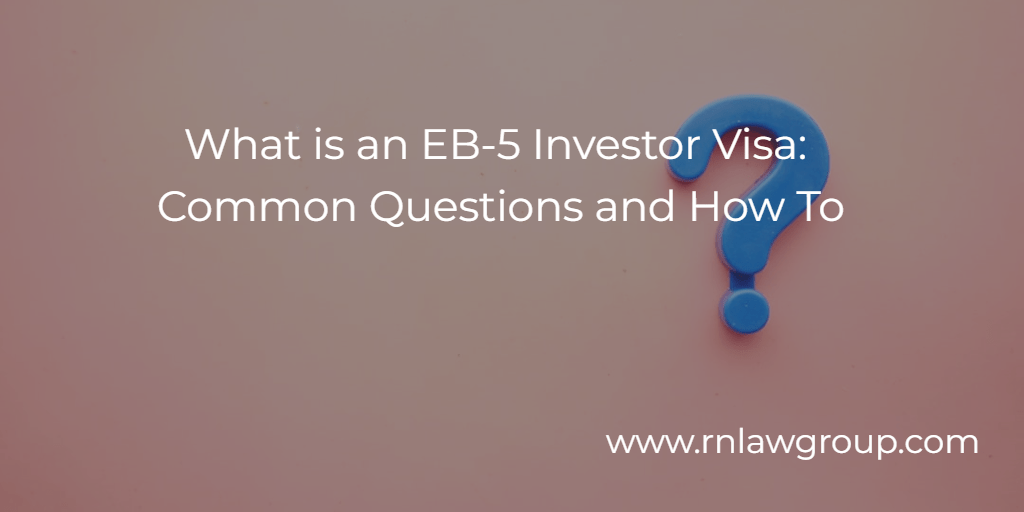
What is an EB-5 Investor Visa: Common Questions and How To
With the intention and purpose of creating sustained job growth in the United States for American citizens, the EB-5 Investor visa program allows foreign nationals to invest certain minimum amounts of capital into a new and existing projects or businesses across the county. To further serve this purpose and to encourage economic growth in low-employment and/or rural areas, as well as incentivize private investment in public infrastructure, Congress enables investors to invest a lower threshold amount if seeking to create jobs in a wide array of geographically targeted employment areas. In exchange for this capital investment and upon proof that the investment has created at least 10 full-time jobs for US workers, the foreign national and their spouse and children receive permanent residency in the United States, otherwise known as a Green Card or Lawful Permanent Residence.
Ultimately, an EB-5 visa is considered an employment-based Green Card. While there is a universe of avenues to obtain an employment-based green card, the overwhelming majority of these avenues should be considered employer-driven or employer-sponsored, rather than employee-driven or otherwise “self-petitioned”. When seeking an EB-5 investor visa (aka EB-5 Green Card), the foreign national investor is able to self-petition as a direct or indirect investor in a new or on-going commercial enterprise, the idea being this investment will create and sustain a host of jobs for US workers.
The most immediate benefit of the EB-5 investor visa program is that the foreign national themselves is able to take control of their immigration journey from the very start. In the EB-5 context, the foreign national investor is able to avoid a number of the typical constraints and procedures required of those seeking “typical” employer-driven employment-based green cards. Instead, the EB-5 foreign national is entitled to self-petition as a direct or indirect investor in a commercial enterprise which will or has created jobs in the US for US workers. While the EB-5 foreign national investor is able to skip or avoid certain “typical” procedures inherent in the usual Green Card process, in doing so the foreign national realizes, supplants, and must subsequently overcome an entirely new set of legal constraints and procedures, such as but certainly not limited to the bona fide existence of the investment, viability of the business model, proof of clean and traceable “at-risk” investment funds, proof of US jobs creation, and much more.
Often times, particularly for citizens of the India or China, individuals and families face immense decades-long backlogs for approval of a “typical” Green Card, or lawful permanent residency. Therefore, as a secondary benefit the EB-5 program typically allows individuals of any nation to lawfully circumvent existing visa-backlogs in large part due to providing this immense, job-creating investment in the United States.
What is the required investment amount?
The required investment amount will generally depend upon the geographic area of intended job creation, i.e. geographic area of investment. Readers should recognize that the investment amounts detailed in this article are subject to change; adjustments occur every five years based on inflation and is tied to the Consumer Price Index (CPI). The below-detailed amounts should remain undisturbed until 2027.
USCIS has set two levels of minimum investment required for an acceptable EB-5 green card petition.
The standard amount is $1,050,000; this amount is required where the investor seeks job creation outside of a government-delineated Targeted Employment Area (TEA). A standard investment amount can be in a direct investment scenario or in an EB-5 regional center and can be anywhere in the United States.
USCIS also allows for a reduced investment amount of $800,000; this amount is required where the investor seeks job creation inside of a government-delineated Targeted Employment Area (TEA). A reduced investment amount can be a direct investment scenario or in an EB-5 regional center, so long as the investment/job creation is in a Targeted Employment Area (TEA). More often than not, EB-5 investors will utilize indirect investment in an EB-5 Regional Center operating in a Targeted Employment Area (TEA). This can be considered the “path of least resistance” but caution is required—this is likely the scenario where the highest levels of due diligence and therefore investor confidence are required.
This website is an effective tool identifying the geographic areas which do and do not qualify as a Targeted Employment Area (TEA).
How do you file an EB-5 Green Card?
As there are a number of “typical” employment-based Green Card avenues, so too are there a number of available EB-5 Investor Green Card avenues. From the outset, the Foreign National must decide if they seek to invest directly or indirectly in a business enterprise. As an example, one might invest directly in an enterprise they seek to or have already established themselves in the United State. Similarly, one might invest directly in a new or existing enterprise in which they seek a degree of managerial or executive control. In this context, it is the foreign national’s own “business enterprise” which will be creating the ten (10) jobs directly. An individual seeking an EB-5 investor green card through their direct investment would file an I-526, Immigrant Petition by Standalone Investor.
When submitted the I-526, Immigrant Petition by Standalone Investor, the direct investor will generally need to demonstrate 1) the existence of a commercial enterprise, 2) the “at-risk” investment of the required capital amount in the enterprise, 3) proof of the source of capital investment funds as bona fide and legitimate, as well as 4) a comprehensive business plan demonstrating or otherwise proving creation of at least ten (10) jobs for US workers.
Alternatively, a foreign national investor may seek to indirectly invest through a third-party entity, such as through an EB-5 regional center investment. In this context, it is the third-party entity that is responsible for creating the ten (10) required jobs and the jobs can be directly created by that entity or indirectly created through the projects/investments impact on the surrounding community. An individual seeking an EB-5 investor green card through their indirect investment would file an I-525E, Immigrant Petition by Regional Center Investor.
When submitting the I-526E, Immigrant Petition by Regional Center Investor, the indirect investor’s work is generally done for them. In this context, the indirect investor most still demonstrate the “at-risk” investment of the required capital amount in the regional center and/or enterprise as well as proof of the source of capital investment funds as bona fide and legitimate. However, the indirect investor does not need to provide their own business plan or proof of direct job creation. Instead, the regional center entity will provide to the EB-5 investor all the business plans and job creation documentation required by USCIS.
By : Ryan A. Wilck, Partner and Attorney at Law
Ryan Wilck is a Managing Partner and attorney at Reddy Neumann Brown PC with over a decade of US immigration law experience, enthusiastic and proactive in his approach assisting investors and their families through the various phases of the EB-5 process.. “Concilio et labore” is not only the motto of Ryan’s favorite sports club but is also his life’s motto; all things come through wisdom and effort. Ryan is passionate about gaining the trust of his clients by utilizing a relentless and detail-oriented approach to understand their specific goals and concerns, hoping to instill a sense of confidence and stability. Whatever your immigration problem or interest, he and his team will find a solution, through wisdom and effort. Reddy Neumann Brown PC has been serving the business and investor community for over 20 years and is Houston’s largest immigration law firm focused solely on employment-based business immigration. We work with investors, employers and their employees, helping navigate the complex immigration process efficiently and cost-effective.
We are committed to assisting our clients navigating the utilization of available yet complex EB-5 investment avenues–either directly or indirectly through EB-5 regional centers—as well as the required acceptable capital investment analysis, business plan due diligence, job creation analysis, and other challenging immigration matters as an accomplished immigration law firm in Houston, Texas. Our team is here to offer the direction and support you require, whether you’re a company trying to hire top talent or a foreign investor seeking to develop a business enterprise or business empire in the United States. To find out more about how we can help you with your immigration issues, get in touch with us right away.

